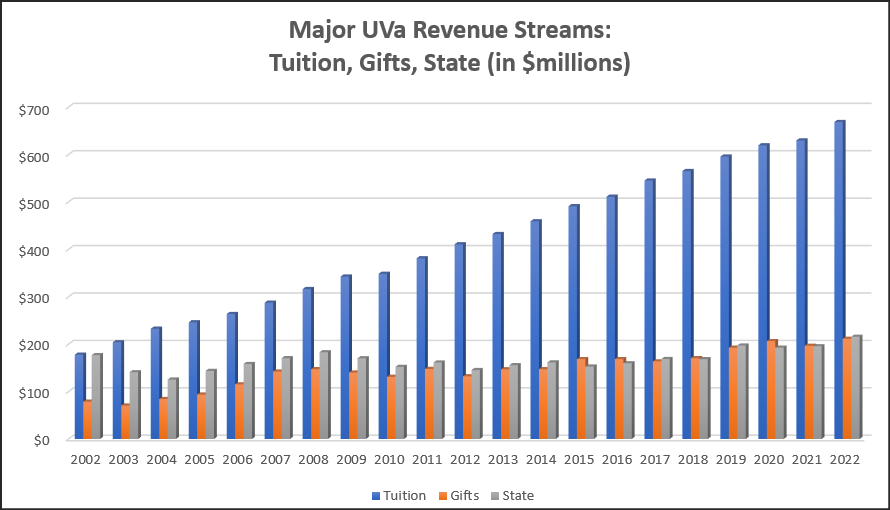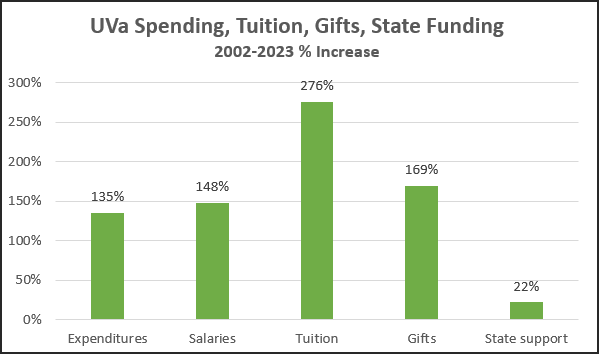
by James A. Bacon
In explaining the cause of rising tuition & fees at the University of Virginia, we described last week how the driving force over the past 20 years has been a relentless increase in spending. Expenditures in the academic division of the University of Virginia, fueled by an expansion in salaries, increased 135% between 2002 and 2022, far outpacing the 59% rise in the Consumer Price Index and 20% increase in enrollment.
But that’s not the whole story. While expenditures were surging, state support for UVa and other public universities in the Old Dominion lagged far behind. Colleges and universities, the higher-ed lobby has argued, have had little choice but to offset public parsimony by raising tuition & fees.
A Jefferson Council analysis suggests that there is some truth to this assertion at UVa but it falls woefully short in explaining the ascent of tuition & fees to stratospheric levels. After adjusting for inflation and enrollment growth, roughly 30% of the tuition hikes have offset the decline in state funding while 70% went toward higher spending.
While coping with stagnant state funding, UVa presidents and Boards of Visitors looked to increased gifts and higher tuition to pay for their aggressive spending increases. Gifts have surged over the 20-year period and now equal state support as a source of funding at UVa. But the bulk of new revenue has come from tuition hikes.

Between 2002 and 2022, according to data pulled from UVa’s annual reports, revenue from tuition increased from $178 million to $669 million. If tuition revenue had tracked 59% inflation and 20% enrollment growth over that period, it would have been only $319 million. The surplus amounts to $350 million.
In 2002, the state contribution to UVa was $177 million. By 2022, the sum had risen to $216 million. Adjusted for inflation and enrollment growth, this did represent a decline in state support, as university officials frequently remind everyone. Had state support increased in concert with the CPI and enrollment, it would have reached $317 million. The state funding gap, therefore, can be reckoned at $101 million.
In summary:
State funding gap — $101 million.
Surplus tuition revenue — $350 million.
Funding gap as percentage of surplus tuition revenue: 29%.
The biggest driver of tuition increases is out-of-control spending, a phenomenon that should surprise no one when we consider the professional backgrounds of UVa’s past three presidents: English professor (John Casteen), sociology professor (Teresa Sullivan), and lawyer/education school dean (Jim Ryan). Business productivity has been a secondary concern compared to the quest for institutional prestige and, in recent years, the pursuit of “social justice.”
Profligate behavior long precedes the Ryan administration, and successive Boards of Visitors can be faulted for failing to hold administrators accountable. Even alumni, who continue to shower donations and bequests upon the university in support of sexy new buildings and spending programs, bear their share of responsibility.
But a day of reckoning is coming. UVa has maxed out the patience of students and their families, of taxpayers and politicians, and of many alumni, and the Ryan administration seems oblivious to their concerns. A growing number of UVa stakeholders are questioning the value proposition of an education that charges $60,000 to $75,000 yearly (out-of-state undergraduates) and turns many students into slogan-chanting woke-bots. A Youngkin-appointed board of visitors will no longer be satisfied with the palliatives and platitudes of the status quo.




I reiterate … institutions of higher learning are pricing themselves out of the market. On line universities will be the norm. Main street universities will cease to exist. They have just become indoctrination centers anyway, so no loss there.
I would see that the University is in need of some energized cost accountants. Change can not come soon enough. Bravo to the Jefferson Council for taking a leadership role in this and many other areas of concern.
It is axiomatic that people go on nonprofit boards and suspend their business and financial senses to go along with management.
From a prior Jefferson Council post:
“The University of Virginia’s vice president for diversity, equity & inclusion told the New York Times that UVa has only 40 DEI employees — half the number counted by the Virginia Association of Scholars.”
As long as they have money for DEI, they have too much money.